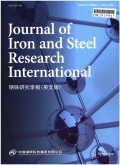- 钛学术文献服务平台 \
- 学术期刊 \
- 工业技术期刊 \
- 冶金工业期刊 \
- 钢铁研究学报(英文版)期刊 \
Behavior of liquid passing through deadman:influence of slag/iron ratio and unburned pulverized coal
Behavior of liquid passing through deadman:influence of slag/iron ratio and unburned pulverized coal
基本信息来源于合作网站,原文需代理用户跳转至来源网站获取
摘要:
The ability of a blast furnace hearth liquid (iron and slag) passing through deadman characterizes the activity of the blast furnace hearth. To explore the influence of various factors on the static holdup rate of liquid in the process of passing through the deadman, a physical transport model of liquid passing through the deadman was firstly established. Then, a self-designed experimental device was used to simulate the process, and the influences of slag/iron ratios (250–450 kg/t) and unburned coal content (0%–9%) on the static holdup rate were studied. The experimental results indicate that with the slag/iron ratio increasing, the behavior of liquid passing through the coke packed bed gets much more difficult, and the static holdup rate increases. As the content of unburned pulverized coal (UPC) increases, the static holdup rate decreases first and then rises. This is caused by the dual effects of UPC. On the one hand, UPC can promote the carburizing reaction of unsaturated molten iron, thereby improving the fluidity of molten iron and reducing the static holdup rate. On the other hand, when the content of UPC rises to a certain level, it will be regarded as a kind of solid particle which will increase the liquid viscosity, causing an increase in the static holdup rate. Moreover, the liquid and coke will present interfacial chemical reactions when the liquid flows through the coke packed bed. And the Si-containing iron droplets at the slag–coke interface, generated by the reaction of SiO2 with C in the coke, can improve the interface wettability by reducing the interface wetting angle and increase the basicity of slag by consuming SiO2, thus improving the fluidity of the liquid and reducing the static holdup rate.

推荐文章
Influence of litter decomposition on iron and manganese in the sediments of wetlands for acid mine d
AMD
Sediments
Litter decomposition
Forms of Fe and Mn
The influence of climate and topography on chemical weathering of granitic regoliths in the monsoon
Granitic regolith
Chemical weathering
Supply-limited weathering
Kinetic-limited weathering
血清sLAG-3和DDK-1在胃癌诊断中的价值
胃癌?
可溶性淋巴细胞活化基因-3?
Dickkopf-1蛋白?
早期诊断
A re-assessment of nickel-doping method in iron isotope analysis on rock samples using multi-collect
Fe isotope
Ni-doping
Stable isotope
Precision and accuracy
Mass bias correction
Pseudo-high mass resolution
内容分析
关键词云
关键词热度
相关文献总数
(/次)
(/年)
文献信息
| 篇名 | Behavior of liquid passing through deadman:influence of slag/iron ratio and unburned pulverized coal | ||
| 来源期刊 | 钢铁研究学报(英文版) | 学科 | |
| 关键词 | |||
| 年,卷(期) | 2021,(9) | 所属期刊栏目 | ORIGINAL PAPERS |
| 研究方向 | 页码范围 | 1095-1104 | |
| 页数 | 10页 | 分类号 | |
| 字数 | 语种 | 英文 | |
| DOI | |||
五维指标
引文网络
引文网络
二级参考文献 (0)
共引文献 (0)
参考文献 (1)
节点文献
引证文献 (0)
同被引文献 (0)
二级引证文献 (0)
2017(1)
- 参考文献(1)
- 二级参考文献(0)
2021(0)
- 参考文献(0)
- 二级参考文献(0)
- 引证文献(0)
- 二级引证文献(0)
引文网络交叉学科
相关学者/机构
期刊影响力
钢铁研究学报(英文版)
主办单位:
钢铁研究总院
出版周期:
月刊
ISSN:
1006-706X
CN:
11-3678/TF
开本:
大16开
出版地:
北京市海淀区学院南路76号
邮发代号:
创刊时间:
1994
语种:
eng
出版文献量(篇)
2637
总下载数(次)
0
总被引数(次)
11488
期刊文献
相关文献
推荐文献
- 期刊分类
- 期刊(年)
- 期刊(期)
- 期刊推荐
一般工业技术
交通运输
军事科技
冶金工业
动力工程
化学工业
原子能技术
大学学报
建筑科学
无线电电子学与电信技术
机械与仪表工业
水利工程
环境科学与安全科学
电工技术
石油与天然气工业
矿业工程
自动化技术与计算机技术
航空航天
轻工业与手工业
金属学与金属工艺
钢铁研究学报(英文版)2022
钢铁研究学报(英文版)2021
钢铁研究学报(英文版)2020
钢铁研究学报(英文版)2019
钢铁研究学报(英文版)2018
钢铁研究学报(英文版)2017
钢铁研究学报(英文版)2016
钢铁研究学报(英文版)2015
钢铁研究学报(英文版)2014
钢铁研究学报(英文版)2013
钢铁研究学报(英文版)2012
钢铁研究学报(英文版)2011
钢铁研究学报(英文版)2010
钢铁研究学报(英文版)2009
钢铁研究学报(英文版)2008
钢铁研究学报(英文版)2007
钢铁研究学报(英文版)2006
钢铁研究学报(英文版)2005
钢铁研究学报(英文版)2004
钢铁研究学报(英文版)2003
钢铁研究学报(英文版)2002
钢铁研究学报(英文版)2001
钢铁研究学报(英文版)2000
钢铁研究学报(英文版)1999
钢铁研究学报(英文版)2021年第9期
钢铁研究学报(英文版)2021年第8期
钢铁研究学报(英文版)2021年第7期
钢铁研究学报(英文版)2021年第6期
钢铁研究学报(英文版)2021年第5期
钢铁研究学报(英文版)2021年第4期
钢铁研究学报(英文版)2021年第3期
钢铁研究学报(英文版)2021年第2期
钢铁研究学报(英文版)2021年第12期
钢铁研究学报(英文版)2021年第1期

 免费查重
免费查重










